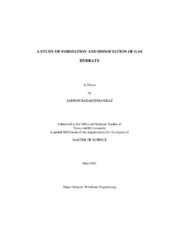| dc.description.abstract | The estimation of gas hydrate volume in closed systems such as pipelines during shut-in time has a great industrial importance. A method is presented to estimate the volume of formed or decomposed gas hydrate in closed systems. The method was used to estimate the volume of formed gas hydrate in a gas hydrate crystallizer under different subcoolings of 0.2, 0.3, 0.6 and 4.6 degrees C, and initial pressures of 2000 and 2500 psi. The rate of gas hydrate formation increased with increases in subcooling and initial pressure. The aim of the second part of the study was the evaluation of the formation of gas hydrate and ice phases in a super-cooled methane-water system under the cooling rates of 0.45 and 0.6 degrees C/min, and the initial pressures of 1500, 2000 and 2500 psi, in pure and standard sea water-methane gas systems. The high cooling rate conditions are likely to be present in pipelines or around a wellbore producing from gas hydrate reservoir. Results showed that the initial pressure and the chemical composition of the water had little effect on the ice and gas hydrate formation temperatures, which were in the range of -8 +/- 0.2 degrees C in all the tests using the cooling rate of 0.45 degrees C/min. In contrast, the increase in the cooling rate from 0.45 to 0.6 degrees C/min decreased the ice and gas hydrate formation temperatures from -8 degrees C to -9 degrees C. In all tests, ice formed immediately after the formation of gas hydrate with a time lag less than 2 seconds. Finally, an analytical solution was derived for estimating induced radial and tangential stresses around a wellbore in a gas hydrate reservoir during gas production. Gas production rates between 0.04 to 0.12 Kg of gas per second and production times between 0.33 to 8 years were considered. Increases in production time and production rate induced greater radial and tangential stresses around the wellbore. | en |


